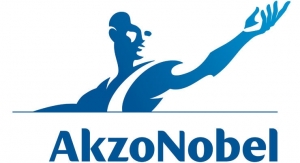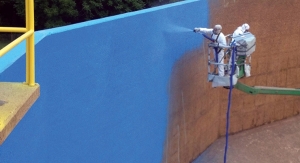03.27.17
As much of the nation’s wastewater and sewer infrastructure approaches the 50-100 year mark, it must be rehabilitated to remain in use for a growing population. Yet municipal wastewater treatment facilities, sewers and vaults endure some of the most severe and corrosive environments in the water industry and must pass increasing Environmental Protection Agency (EPA) scrutiny. At industrial plants as well, EPA enforces requirements to ensure that industries pre-treat pollutants in their wastes to protect local sanitary sewers and wastewater treatment plants.
Such extreme wastewater handling environments operate under continual chemical exposure and heavy abrasion that deteriorate concrete and corrode steel in clarifiers, containment pits, anaerobic digesters, manholes, tanks, and other infrastructure assets.
A variety of factors can cause these structures to develop sizable cracks through which wastewater can escape (exfiltration) or groundwater can enter the wastewater system (infiltration). Leaks, cracks and damage to existing coating systems not only top the list of challenges in facility maintenance and new construction, but can also trigger severe penalties if municipalities or industrial facilities are found in violation of EPA judicial consent decrees.
The need to update and rehab concrete wastewater infrastructures is urgent. Since most concrete wastewater infrastructure is over 50 years old, and outdated in the process, upgrading and rehabilitation is an urgent issue as it will only get worse. Many of the earlier structures were designed and put into service without consideration for protection of the concrete. This issue has been recognized and is being addressed by EPA organizations such as SSPC: The Society for Protective Coatings and NACE: National Association of Corrosion Engineers, who are taking positive steps to identify and develop performance standards for coating requirements and use in these application areas. This includes work for rehabilitation, as well as new construction for protection at the start.
The regions of the USA where needs are the greatest are in the older city locations, and areas were population booms are exceeding the capacity of the treatment facilities. Flood prone areas can also have an affect. This is due to the changes in the treatment process, based upon system demand, where higher chemical treatment loads may be used to keep up with the supply of waste, and water purification. Also, areas where there has been significant industrial growth, as that waste will be different in composition to house-hold waste. It all puts a significantly greater burden on the treatment facilities.
Seasonal changes can and do put extra burden on older facilities. In the winter, there is the freeze-thaw cycling, where water gets into the cracks, freezes and expands those cracks, thus resulting in more leak and erosion potential. Spring time usually means more rain, and that higher inflow of rainwater can affect the treatment process, extra burden, treatment chemical change that attacks the concrete. Summer, being hotter and dryer, can affect the soil and stability.
Fortunately, advanced polyurea coatings and liners are proving ideal for wastewater infrastructure rehabilitation by delivering strong, flexible, abrasion and chemical-resistant waterproofing that not only bridges existing cracks, but can elongate up to 400% without cracking. Because they set and cure rapidly, and can be installed and used in a wide range of temperatures, they also minimize facility downtime.
Cracks can develop in aging concrete wastewater infrastructure for a number of reasons ranging from earth movement to daily or seasonal temperature changes that cause expansion and contraction including freeze-thaw. Additionally harsh chemicals used to treat wastewater can deteriorate the concrete, as can exposure to hydrogen sulfide gas, a form of sulfuric acid present in sewers created by anaerobic organisms.
Since the EPA regulates municipal wastewater and stormwater management, concrete cracks or leaks that lead to wastewater exfiltration or groundwater infiltration can put the municipality in violation of a judicial consent decree, triggering significant penalties. Consent decrees are settlements in judicial actions that are signed by all involved parties and filed in the appropriate court.
“If the EPA finds that a municipality has old leaking sewer systems, putting them on a consent decree can mean that they don’t receive federal tax money until the problem is fixed,” says Jim Osborn, President of Osborn Contract Services Inc., a South Carolina-based certified applicator of spray applied coatings and rehabilitation products.
According to Osborn, a cementitious material is traditionally used to repair wastewater-related sewer leaks, but this has disadvantages, as do other coating materials.
“Hydrogen sulfide gas eats away at the cement in sewer concrete, so it may only have a lifespan of a few years,” says Osborn. “Because epoxies are limited by much lower elongation properties, they crack and don’t bridge cracks well. Polyurethanes have more elongation, but nothing like polyureas.”
For concrete repairs in wastewater infrastructure from municipal manholes and lift stations to clarifiers, trenches and sumps, Osborn has transitioned to an advanced polyurea system from VersaFlex, a manufacturer of spray applied protective coatings and waterproof membranes for the U.S. wastewater and industrial markets.
The spray applied waterproof coating creates a seamless, waterproof, durable protective liner that stops leaks and strengthens the integrity of the entire structure. It exhibits superior physical properties such as elongation up to 400%, crack bridging, hardness, and tensile strength to create a robust industrial liner that protects, strengthens, and waterproofs concrete wastewater infrastructure.
According to Osborn, a number of the polyurea’s characteristics help to extend wastewater infrastructure longevity as well as prevent wastewater exfiltration and groundwater infiltration.
“Since the polyurea system provides superior elongation, it bridges cracks up to 1/8”, says Osborn. “With tensile strength higher than traditional materials, it has much lower permeability for better waterproofing. Its impact, abrasion, and chemical resistance are excellent so it resists hydrogen sulfide. Instead of years between the replacement of cementitious coatings, the polyurea coating can cost-effectively provide decades of protection.”
With the proper crack repair and surface preparation, the polyurea coating can be a thick film applied directly to the concrete or similar substrate. An alternate application method that can sometimes mitigate the need for surface or crack repairs is to pre-spray the polyurea to geotextile fabric panels placed above the onsite substrate, fusing the panel edges together with more polyurea.
Because of the polyurea’s ability to set and cure quickly, it also minimizes wastewater treatment plant or infrastructure downtime. This can translate into thousands of dollars per hour savings as well as avoiding days of service interruption.
When extensive cracks were found in a concrete clarifier shortly before a chemical plant’s ribbon cutting ceremony, Osborn turned to the polyurea for superior protection and fast installation.
After repairing all cracks over 1/8” wide in the clarifier with a concrete repair grout, Osborn prepared, then primed the floor and walls with VersaFlex VF 20 primer, and applied 80-100 mils of FSS 45DC polyurea.
“The polyurea allowed us to provide a warranty against potential future cracks opening in the concrete because of its crack bridging ability,” said Osborn. “We were able to spray the polyurea as thick as needed in one application. Since it sets and cures rapidly, structures can put be back in service very soon after spraying.”
While traditional coatings such as cementitious, epoxies, and polyurethanes will prematurely fail if not installed under a relatively narrow range of temperatures, the polyurea is designed for installation and use from -40°F to +350°F. It will withstand decades of freeze-thaw cycling, and wide variations of temperature and humidity.
“When you’re above ground in the Midwest, you have freeze and thaw with concrete expansion, contraction, and cracking,” says Jennifer Hoop, President of Conco Spray Solutions, an Indianapolis, IN-based contractor specializing in the rehabilitation and protection of municipal infrastructure including potable, storm and wastewater systems. “We needed a lining that would move with the structure through the different seasons and tank temperature differentials. For that, polyurea works very well.”
To withstand extreme weather conditions at a northern Indiana wastewater treatment plant, Hoop selected the polyurea for a secondary containment area around ferric chloride tanks. “After filling in cracks with grout and restoring the concrete, we sprayed the polyurea on geotextile to provide a really nice containment area for the ferric chloride tanks,” she says.
Hoop, whose company does a large amount of wastewater-related work on containment, clarifiers, tanks, and wet wells, says that the polyurea has an added benefit in reducing continual clarifier maintenance. “Typically clarifier maintenance crews need to use high-pressure power washers for hours to clean solid waste from concrete surfaces,” says Hoop. “Since the polyurea provides waterproofing and has a cleanable surface, crews can simply hose down the clarifier to clean it. This can cut required weekly clarifier cleaning by two-thirds.”
“For wastewater-related rehabilitation, polyurea is a superior coating for any application that requires crack bridging, longevity, chemical and temperature resistance, as well as fast turnaround,” concludes Hoop.
Such extreme wastewater handling environments operate under continual chemical exposure and heavy abrasion that deteriorate concrete and corrode steel in clarifiers, containment pits, anaerobic digesters, manholes, tanks, and other infrastructure assets.
A variety of factors can cause these structures to develop sizable cracks through which wastewater can escape (exfiltration) or groundwater can enter the wastewater system (infiltration). Leaks, cracks and damage to existing coating systems not only top the list of challenges in facility maintenance and new construction, but can also trigger severe penalties if municipalities or industrial facilities are found in violation of EPA judicial consent decrees.
The need to update and rehab concrete wastewater infrastructures is urgent. Since most concrete wastewater infrastructure is over 50 years old, and outdated in the process, upgrading and rehabilitation is an urgent issue as it will only get worse. Many of the earlier structures were designed and put into service without consideration for protection of the concrete. This issue has been recognized and is being addressed by EPA organizations such as SSPC: The Society for Protective Coatings and NACE: National Association of Corrosion Engineers, who are taking positive steps to identify and develop performance standards for coating requirements and use in these application areas. This includes work for rehabilitation, as well as new construction for protection at the start.
The regions of the USA where needs are the greatest are in the older city locations, and areas were population booms are exceeding the capacity of the treatment facilities. Flood prone areas can also have an affect. This is due to the changes in the treatment process, based upon system demand, where higher chemical treatment loads may be used to keep up with the supply of waste, and water purification. Also, areas where there has been significant industrial growth, as that waste will be different in composition to house-hold waste. It all puts a significantly greater burden on the treatment facilities.
Seasonal changes can and do put extra burden on older facilities. In the winter, there is the freeze-thaw cycling, where water gets into the cracks, freezes and expands those cracks, thus resulting in more leak and erosion potential. Spring time usually means more rain, and that higher inflow of rainwater can affect the treatment process, extra burden, treatment chemical change that attacks the concrete. Summer, being hotter and dryer, can affect the soil and stability.
Fortunately, advanced polyurea coatings and liners are proving ideal for wastewater infrastructure rehabilitation by delivering strong, flexible, abrasion and chemical-resistant waterproofing that not only bridges existing cracks, but can elongate up to 400% without cracking. Because they set and cure rapidly, and can be installed and used in a wide range of temperatures, they also minimize facility downtime.
Cracks can develop in aging concrete wastewater infrastructure for a number of reasons ranging from earth movement to daily or seasonal temperature changes that cause expansion and contraction including freeze-thaw. Additionally harsh chemicals used to treat wastewater can deteriorate the concrete, as can exposure to hydrogen sulfide gas, a form of sulfuric acid present in sewers created by anaerobic organisms.
Since the EPA regulates municipal wastewater and stormwater management, concrete cracks or leaks that lead to wastewater exfiltration or groundwater infiltration can put the municipality in violation of a judicial consent decree, triggering significant penalties. Consent decrees are settlements in judicial actions that are signed by all involved parties and filed in the appropriate court.
“If the EPA finds that a municipality has old leaking sewer systems, putting them on a consent decree can mean that they don’t receive federal tax money until the problem is fixed,” says Jim Osborn, President of Osborn Contract Services Inc., a South Carolina-based certified applicator of spray applied coatings and rehabilitation products.
According to Osborn, a cementitious material is traditionally used to repair wastewater-related sewer leaks, but this has disadvantages, as do other coating materials.
“Hydrogen sulfide gas eats away at the cement in sewer concrete, so it may only have a lifespan of a few years,” says Osborn. “Because epoxies are limited by much lower elongation properties, they crack and don’t bridge cracks well. Polyurethanes have more elongation, but nothing like polyureas.”
For concrete repairs in wastewater infrastructure from municipal manholes and lift stations to clarifiers, trenches and sumps, Osborn has transitioned to an advanced polyurea system from VersaFlex, a manufacturer of spray applied protective coatings and waterproof membranes for the U.S. wastewater and industrial markets.
The spray applied waterproof coating creates a seamless, waterproof, durable protective liner that stops leaks and strengthens the integrity of the entire structure. It exhibits superior physical properties such as elongation up to 400%, crack bridging, hardness, and tensile strength to create a robust industrial liner that protects, strengthens, and waterproofs concrete wastewater infrastructure.
According to Osborn, a number of the polyurea’s characteristics help to extend wastewater infrastructure longevity as well as prevent wastewater exfiltration and groundwater infiltration.
“Since the polyurea system provides superior elongation, it bridges cracks up to 1/8”, says Osborn. “With tensile strength higher than traditional materials, it has much lower permeability for better waterproofing. Its impact, abrasion, and chemical resistance are excellent so it resists hydrogen sulfide. Instead of years between the replacement of cementitious coatings, the polyurea coating can cost-effectively provide decades of protection.”
With the proper crack repair and surface preparation, the polyurea coating can be a thick film applied directly to the concrete or similar substrate. An alternate application method that can sometimes mitigate the need for surface or crack repairs is to pre-spray the polyurea to geotextile fabric panels placed above the onsite substrate, fusing the panel edges together with more polyurea.
Because of the polyurea’s ability to set and cure quickly, it also minimizes wastewater treatment plant or infrastructure downtime. This can translate into thousands of dollars per hour savings as well as avoiding days of service interruption.
When extensive cracks were found in a concrete clarifier shortly before a chemical plant’s ribbon cutting ceremony, Osborn turned to the polyurea for superior protection and fast installation.
After repairing all cracks over 1/8” wide in the clarifier with a concrete repair grout, Osborn prepared, then primed the floor and walls with VersaFlex VF 20 primer, and applied 80-100 mils of FSS 45DC polyurea.
“The polyurea allowed us to provide a warranty against potential future cracks opening in the concrete because of its crack bridging ability,” said Osborn. “We were able to spray the polyurea as thick as needed in one application. Since it sets and cures rapidly, structures can put be back in service very soon after spraying.”
While traditional coatings such as cementitious, epoxies, and polyurethanes will prematurely fail if not installed under a relatively narrow range of temperatures, the polyurea is designed for installation and use from -40°F to +350°F. It will withstand decades of freeze-thaw cycling, and wide variations of temperature and humidity.
“When you’re above ground in the Midwest, you have freeze and thaw with concrete expansion, contraction, and cracking,” says Jennifer Hoop, President of Conco Spray Solutions, an Indianapolis, IN-based contractor specializing in the rehabilitation and protection of municipal infrastructure including potable, storm and wastewater systems. “We needed a lining that would move with the structure through the different seasons and tank temperature differentials. For that, polyurea works very well.”
To withstand extreme weather conditions at a northern Indiana wastewater treatment plant, Hoop selected the polyurea for a secondary containment area around ferric chloride tanks. “After filling in cracks with grout and restoring the concrete, we sprayed the polyurea on geotextile to provide a really nice containment area for the ferric chloride tanks,” she says.
Hoop, whose company does a large amount of wastewater-related work on containment, clarifiers, tanks, and wet wells, says that the polyurea has an added benefit in reducing continual clarifier maintenance. “Typically clarifier maintenance crews need to use high-pressure power washers for hours to clean solid waste from concrete surfaces,” says Hoop. “Since the polyurea provides waterproofing and has a cleanable surface, crews can simply hose down the clarifier to clean it. This can cut required weekly clarifier cleaning by two-thirds.”
“For wastewater-related rehabilitation, polyurea is a superior coating for any application that requires crack bridging, longevity, chemical and temperature resistance, as well as fast turnaround,” concludes Hoop.




















